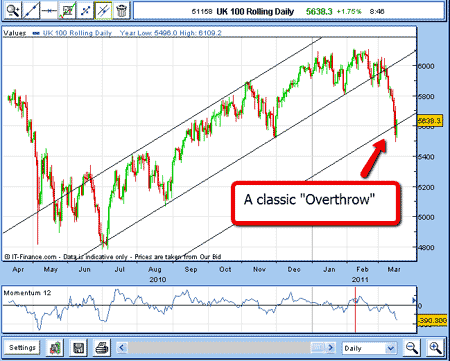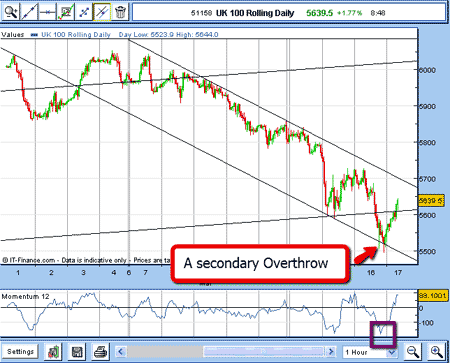Using 'tramline trading' to profit from market volatility
In these volatile times, when markets swing violently up and down, traders need to be on their toes. John C Burford explains how alert spread betters can profit from the markets' moves using Elliot waves and tramline trading techniques.
I covered the FTSE 100 market action in a recent post which covered the first period of post-Japan earthquake trading. I showed that the move up from the summer was well contained within my tramline pair I had drawn weeks ago.
The rally I could count as complete in five Elliott waves at the 6,100 top made in February. I then suggested that the most likely move would be down in a change of trend, having completed a classic five-wave impulse pattern.
The market did indeed move down to toy with my lower tramline, before plunging starting in early March (this was well before the Japan crisis, please note) towards my third tramline, which I had drawn parallel and equidistant from the two original tramlines.
Subscribe to MoneyWeek
Subscribe to MoneyWeek today and get your first six magazine issues absolutely FREE

Sign up to Money Morning
Don't miss the latest investment and personal finances news, market analysis, plus money-saving tips with our free twice-daily newsletter
Don't miss the latest investment and personal finances news, market analysis, plus money-saving tips with our free twice-daily newsletter
Here is that same chart updated to this morning:

(Click on the chart for a larger version)
Since my previous post, the market has indeed plunged very rapidly to my lowest tramline (remember, it was drawn long before the market hit it!) and then overshot it before bouncing back.
This 'overshoot' effect is very common when markets are in free-fall (or free-rise!), and I fully expected it here.
When a trend changes, hunt for new tramlines
But here is the interesting point when a market changes trend, it is a good idea to look for tramlines in the new down trend. And this is what I find in the hourly chart:

(Click on the chart for a larger version)
My upper down-sloping tramline I could draw a couple of days ago, which I did.
To find a valid lower tramline, I used my parallel line tool on my spread betting platform and hovered over the small high made on 1 March.
Lo and behold, it passed right through the first drop to the 5,600 level made last Tuesday. That was my second tramline in place.

Claim your FREE report: The 6-step game-plan for
spread betting profits
The market bounced from the 5,600 level, then fell again right to my new lower tramline and beyond in another 'overshoot'.
Of course, for short-term traders, this was a golden opportunity to take profits on their short trades. The odds then heavily favoured a significant bounce, especially now that momentum was so oversold (marked in the purple box).
As I write, we are seeing that good bounce. An ideal target is, of course, near the upper down-sloping tramline, as this is the operative set at present, while the market is in a broader downtrend.
But the market is hovering around my lower up-sloping tramline, and if this is still a force, the market may not rally too far from it.
We are living in volatile times, which means the trading opportunities are coming at us much more rapidly. If you are a trader, you need to be on your toes, as the swings are becoming wilder.
But using my tramline trading ideas, combined with Elliott wave, Fibonacci, and momentum indicators, it is possible to extract profits from these moves. I hope I am showing you how.
NB: Don't miss my next bit of trading advice. To receive all my spread betting blog posts by email, as soon as I've written them, just sign up here .
Get the latest financial news, insights and expert analysis from our award-winning MoneyWeek team, to help you understand what really matters when it comes to your finances.
John is is a British-born lapsed PhD physicist, who previously worked for Nasa on the Mars exploration team. He is a former commodity trading advisor with the US Commodities Futures Trading Commission, and worked in a boutique futures house in California in the 1980s.
He was a partner in one of the first futures newsletter advisory services, based in Washington DC, specialising in pork bellies and currencies. John is primarily a chart-reading trader, having cut his trading teeth in the days before PCs.
As well as his work in the financial world, he has launched, run and sold several 'real' businesses producing 'real' products.
-
 Will “Liberation Day” strike again?
Will “Liberation Day” strike again?Donald Trump’s 90-day tariff pause comes to an end on 9 July. Can we expect further market turmoil?
-
 Israel claims victory in the '12-day war' with Iran
Israel claims victory in the '12-day war' with IranDonald Trump may have announced a ceasefire in the 12-day war between Israel and Iran, but what comes next depends on what happens internally in Iran